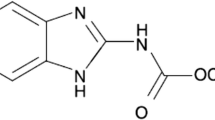Abstract
Microtox™ bioassay was used for assessing the complexation of copper with organic compounds including humic acids and corn root exudates. The bioassay, based on reduction of bacterial luminescence in the presence of toxicants, consists of determining the toxicity of organo-metallic complexes and thus assessing the bioavailability of copper to the test bacteria. Natural organic compounds reduced the extent of copper toxicity. Thus, Microtox can be used as a rapid tool for assessing the interactions of heavy metals with organic ligands.
Similar content being viewed by others
References
Babich H, Stotzky G (1980) Environmental factors that influence the toxicity of heavy metals and gaseous pollutants to microorganisms. Crit Rev Microbiol 8:99–145
Babich H, Stotzky G (1986) Environmental factors affecting the utility of microbial assays for the toxicity and mutagenicity of chemical pollutants. In: Dutka BJ, Bitton G (eds) Toxicity testing using microorganisms, vol 2. CRC Press, Boca Raton, FL, pp 9–42
Beckman Instruments (1982) Microtox system operating manual. No. 015-555-879. Carlsbad, CA
Bitton G (1983) Bacterial and biochemical tests for assessing chemical toxicity in the aquatic environment: A review. CRC Crit Rev Environ Control 13:51–63
Bitton G, Dutka BJ (eds) (1986) Toxicity testing using microorganisms, vol 1. CRC Press, Boca Raton, FL
Bizri Y, Cromer M, Scharff JP, Guillet B, Rouiller J (1984) Constantes de stabilité de complexes organo-minérau. Interactions des ions plombeux avec les composés organiques hydrosolubles des eaux gravitaries de podzol. Geochim Cosmochim Acta 48:227–234
Bulich AA (1986) Bioluminescence assays. In: Bitton G, Dutka BJ (eds) Toxicity testing using microorganisms, vol 1. CRC Press, Boca Raton, FL, pp 57–74
Cortez J, Billes G (1982) Role des ions calcium dans la formation du mucigel de Zea mays. Acta Oecol, Oecol Plant 17:67–78
Dutka BJ, Bitton G (eds) (1986) Toxicity testing using microorganisms, vol. 2. CRC Press, Boca Raton, FL
Gadd GM, Griffiths AJ (1978) Microorganisms and heavy metal toxicity. Microb Ecol 4:303–331
Lepp NW (1981) Effect of heavy metals pollution on plants. Vol 1, Effect of trace metals on plant function. Applied Science Publishers, London
McKeague JA, Cheschire MV, Andreux F, Berthelin J (1986) Organo-mineral complexes in relation to pedogenesis. In: Huang PM (ed) Interactions of soil minerals with natural organics and microbes. Soil Sci Soc Am, Madison, WI
Mench M, Morel JL, Guckert A (1985) Liaison du cadmium avec la fraction macromoléculaire soluble des exsudats racinaires de mais (Zea mays L.). CR Acad Sci 301:379–382
— 1987 Metal binding properties of high molecular weight soluble exudates from maize. Biol Fertil Soils 3:165–169
Morel JL, Mench M, Guckert A (1986) Measurement of Pb2+, Cu2+and Cd2+ binding with mucilage exudates from maize (Zea mays L.) roots. Biol Fertil Soils 2:29–34
Mortensen JL (1963) Complexing of metal by soil organic matter. Soil Sci Soc Am Proc 27:179–186
Reuter JH, Perdue EM (1977) Importance of heavy metal-organic matter interactions in natural waters. Geochem Cosmochim Acta 41:325–334
Schnitzer M, Kahn SU (1972) Humic substances in the environment. Marcel Dekker, New York
Sposito G, Holtzclaw KM, Levesque-Madore CS (1979) Cupric ion complexation by fulvic acid extracted from sewage sludge-soil mixture. Soil Sci Soc Am J 43:1148–1155
Stevenson FJ (1976) Stability constants of Cu2+, Pb2+ and Cd2+ complexes with humic acids. Soil Sci Soc Am J 40:665–672
Stevenson FJ, Ardakani MS (1972) Organic matter reactions involving micronutrients in soils. In: Mordvedt JJ, Giordano PM, Lindsay WL (eds) Micronutrients in agriculture. Soil Sci Soc Am, Madison, WI, pp 79–114
Stevenson FJ, Fitch A (1981) Reactions with organic matter. In: Loneragan JF, Robson AD, Robson AD and Graham RD (eds) Copper in soils and plants. Academic Press, Australia, pp 69–95
Author information
Authors and Affiliations
Rights and permissions
About this article
Cite this article
Morel, J.L., Bitton, G. & Koopman, B. Use of Microtox™for assessing copper complexation with organic compounds. Arch. Environ. Contam. Toxicol. 17, 493–496 (1988). https://doi.org/10.1007/BF01055514
Received:
Revised:
Issue Date:
DOI: https://doi.org/10.1007/BF01055514




